MXA RACE TEST: THE REAL TEST OF THE 2025 HUSQVARNA FC450
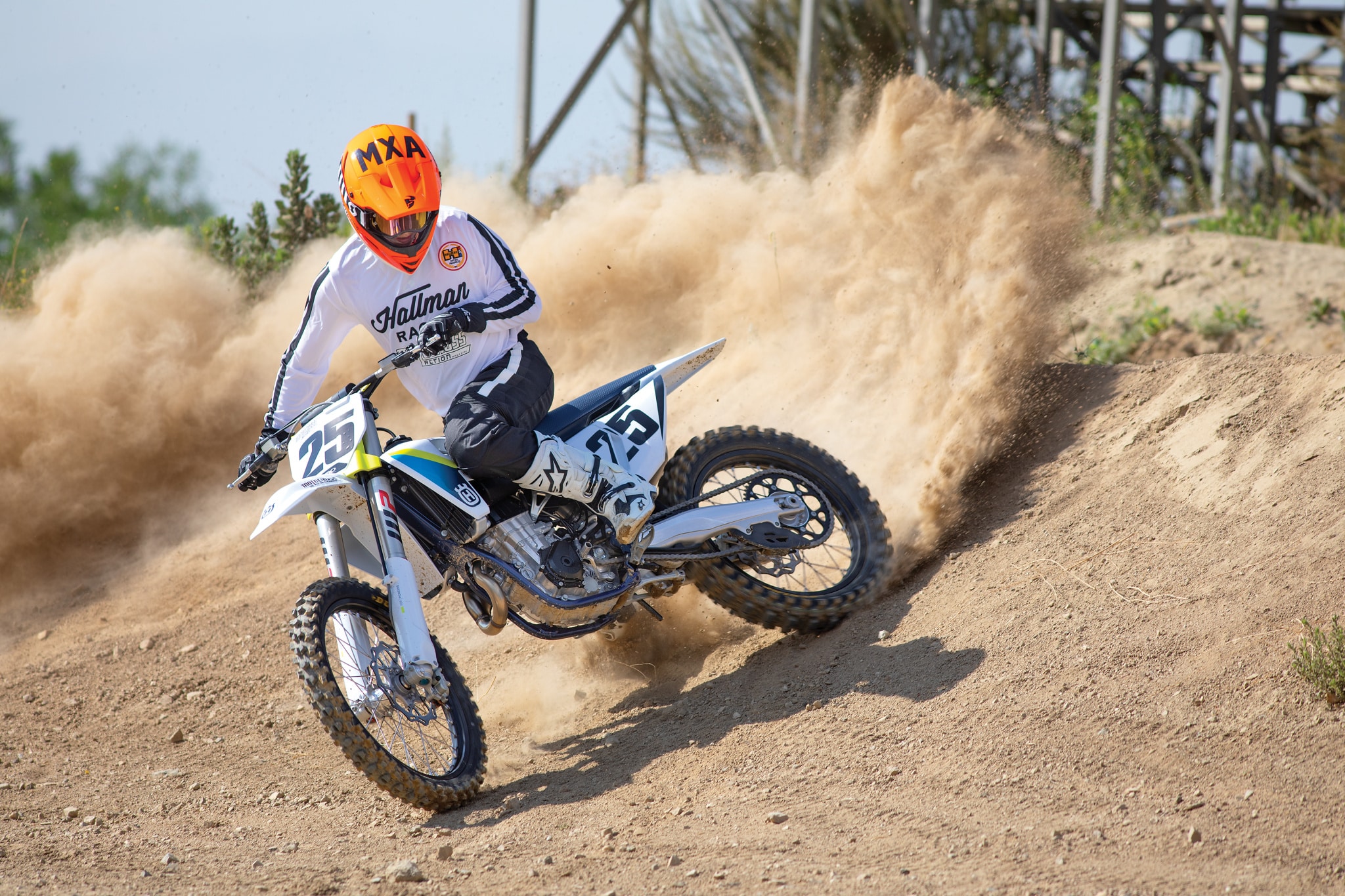
Q: FIRST AND FOREMOST, IS THE 2025 HUSQVARNA FC450 BETTER THAN THE 2024 FC450?
A: Yes. KTM’s engineers did a very good job of addressing the bad things about the 2024 Husqvarna FC450 and enhancing the 2025.
Q: WHAT EFFECT DID THE 2024-1/2 HUSQVARNA FC450 ROCKSTAR EDITION HAVE ON TESTING THE 2025 FC450?
A: It’s no secret that the early-release 2024-1/2 Husqvarna FC450 Rockstar Edition was a precursor to the actual 2025 Husky FC450. It was “next year’s bike now!” The Austrians build Factory Editions because that makes next year’s bike legal in this year’s AMA Supercross series—and because they sell at a premium price.
The 2024-1/2 Husqvarna FC450 Rockstar Edition was especially important for the Austrian brand this winter because it was their answer to the complaints about the overly rigid 2024 model. MXA liked the 2024-1/2 FC450 Rockstar Edition because it gave us an extra four months of test time on what was the yet-to-be-released 2025 Husky FC450.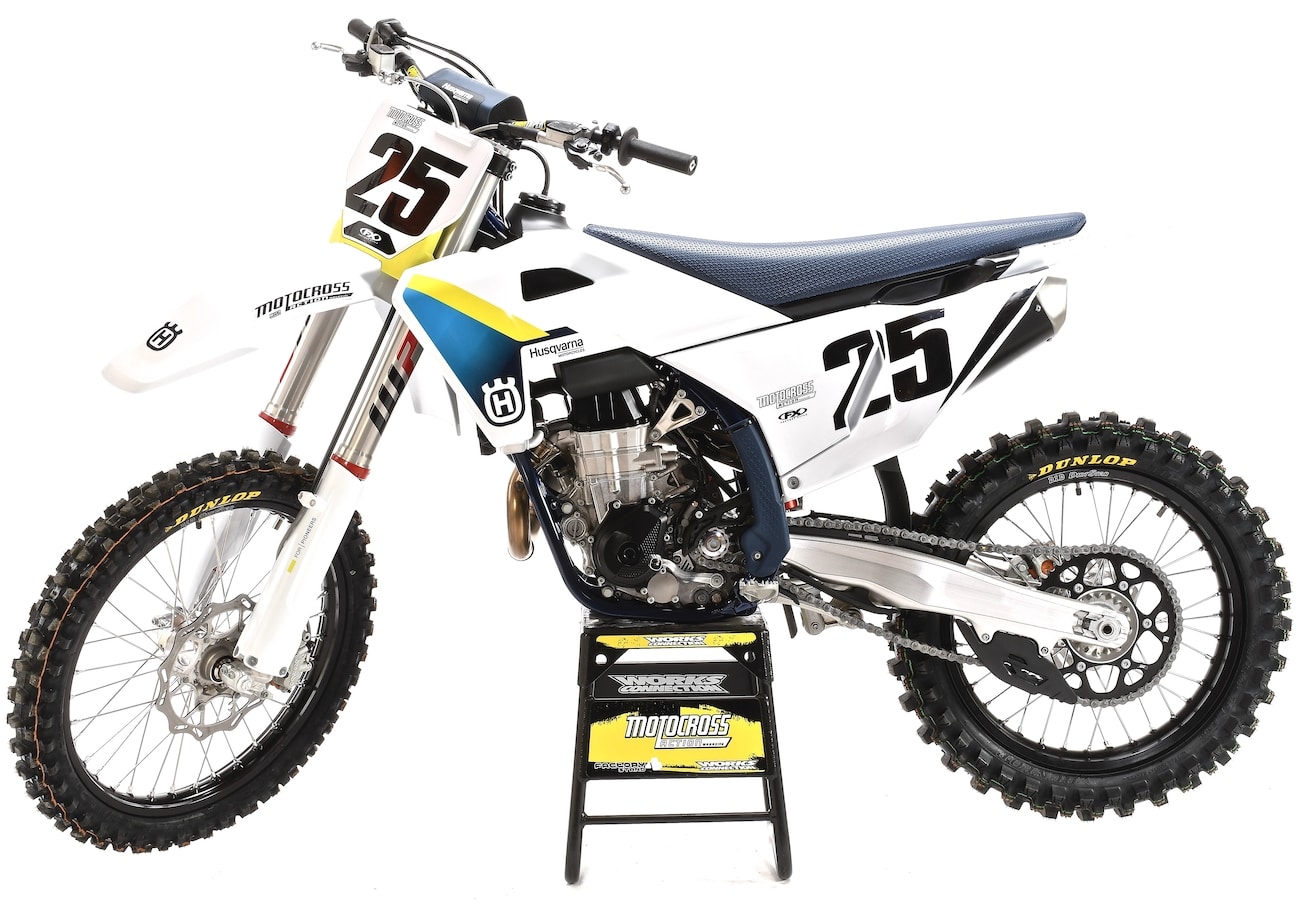
Q: HOW DOES THE 2025 HUSQVARNA DIFFER FROM THE 2024 FC450?
A: Here is a list of the changes made to the 2025 production Husqvarna FC450. MXA describes the changes and explains what they are designed to achieve.
Frame. The most obvious flaw with the 2023-2024 was that the Husky engineers built a frame best suited to the stiffness requirements of most factory riders. The result was a frame that required over 10 hours to take a set—and during the 10-hour break-in period, it was too stiff, harsh and unforgiving for the Novice, Vet, Intermediate and local Pro riders who make up the majority of KTM, Husky and GasGas owners. Not to say that there weren’t fast riders who were very comfortable on the super stiff chassis, just that the average rider doesn’t knock out 10 hours of riding as quickly as a factory rider who hammers out laps every day. KTM, Husky and GasGas took the bad rap, both from its loyal consumers, and, surprisingly, from its high-paid factory riders. Making a plusher chassis was job number one if the Austrian firm wanted to make its buyers happy in 2025. Here is how they went about making the rigid 2024 frame into a resilient 2025 frame.
Shock tower. KTM had replaced its pre-2023 stamped shock tower with a 3mm-thick steel triangulated forging. It was overbuilt. For the 2025 Husqvarna FC450, the forged shock tower has large relief holes cut into both sides to help feed in a little flex.
Forged backbone plates. To stiffen the head tube area in 2023-2024, thick forged steel gussets were welded to the top of the frame’s backbone that wrapped around the steering head. The goal was to stiffen the central control point of the frame, the steering tube, to make the bike turn quicker and more accurately. At the same time, the engineers put a second forged plate on the down tubes, extending below the head tube. We assume this plate was incorporated to better support the steerer tube, which had been prone to breakage in the past.
Frame tubes. On each side of the 2023-2024 KTM chassis, from the shock tower to the footpeg brackets, there are two symmetrical frame tubes. They stiffen the chassis both longitudinally and torsionally, but maybe they did that job a little too well, because for 2025 the engineers replaced the curved tubes with new, thinner-walled chromoly tubing. The goal was to put more spring into chassis movements under high G-loads.
Head stays. Head stays are one of the most commonly changed frame components. These triangle-shaped plates are attached to the frame with two bolts and connected to the cylinder head to help bind the chassis together with the structural mass of the engine. On a yearly basis, you will find manufacturers switching from aluminum to steel head stays, thick to thin head stays, and even recessed head stays. On the 2025 production Husqvarna FC450, the head stays have cast in openings in them to soften up the feel and improve front and rear bite.
Swingarm & buffer pad. Starting in 2023, the Austrians tilted the engine 2 degrees rearward and moved it down 3mm to lessen the 2022-and-earlier chassis’ tendency to squat under hard acceleration. This is unchanged on the 2025 production Husqvarna FC450 because the anti-chain torque was a plus in consecutive whoops, out of bumpy rutted corners, and any time the throttle was held wide open; however, lowering the countershaft sprocket meant that the chain line had to angle downward at a steeper angle than before. The result was that the chain would eat through the swingarm’s buffer pad at the point of the downward arc. If the bike’s owner didn’t catch the wear on the buffer pad soon enough, the chain would start to eat through the aluminum swingarm.
On the new 2025 FC450, Husqvarna’s engineers made the portion of the buffer pad that was getting worn out thinner so that the chain would be able to go over it without destroying it. As a failsafe, the engineers redesigned the swingarm by shaving down the aluminum’s thickness on the top to make it lower. It should be noted that some of the issues with the chain line can be rectified by switching from the stock 13/51 gearing to 14/52 gearing—largely because the larger countershaft sprocket raises the chain line an added degree; however, the gear ratio will be taller.
Q: WHAT IS THE MOST IMPRESSIVE PRODUCTION FACT ABOUT THE 2025 HUSQVARNA FC450?
A: The Austrians do not live by the industry-standard, four-year production cycle like the Japanese brands. Historically, the three Austrian brands make changes in a much shorter cycle and almost always when issues arise that demand their attention.
Take the 2025 Husqvarna FC450 as an example. It was brand new in 2023 and saw no major changes for 2024. According to common logic, it is not due for a major makeover until 2027, but that is not the Austrian way. KTM’s executive officers and engineers were stung by the negative consumer complaints, critical media tests and angry internet chatter that were all centered on how stiff the 2023-2024 chassis was. Worst of all, their factory racers were leading the chorus of boos about the on-track feel of the 2023-2024 frames. As a result, the 2025 Husqvarna FC450 is actually in the showrooms two years earlier than originally expected.
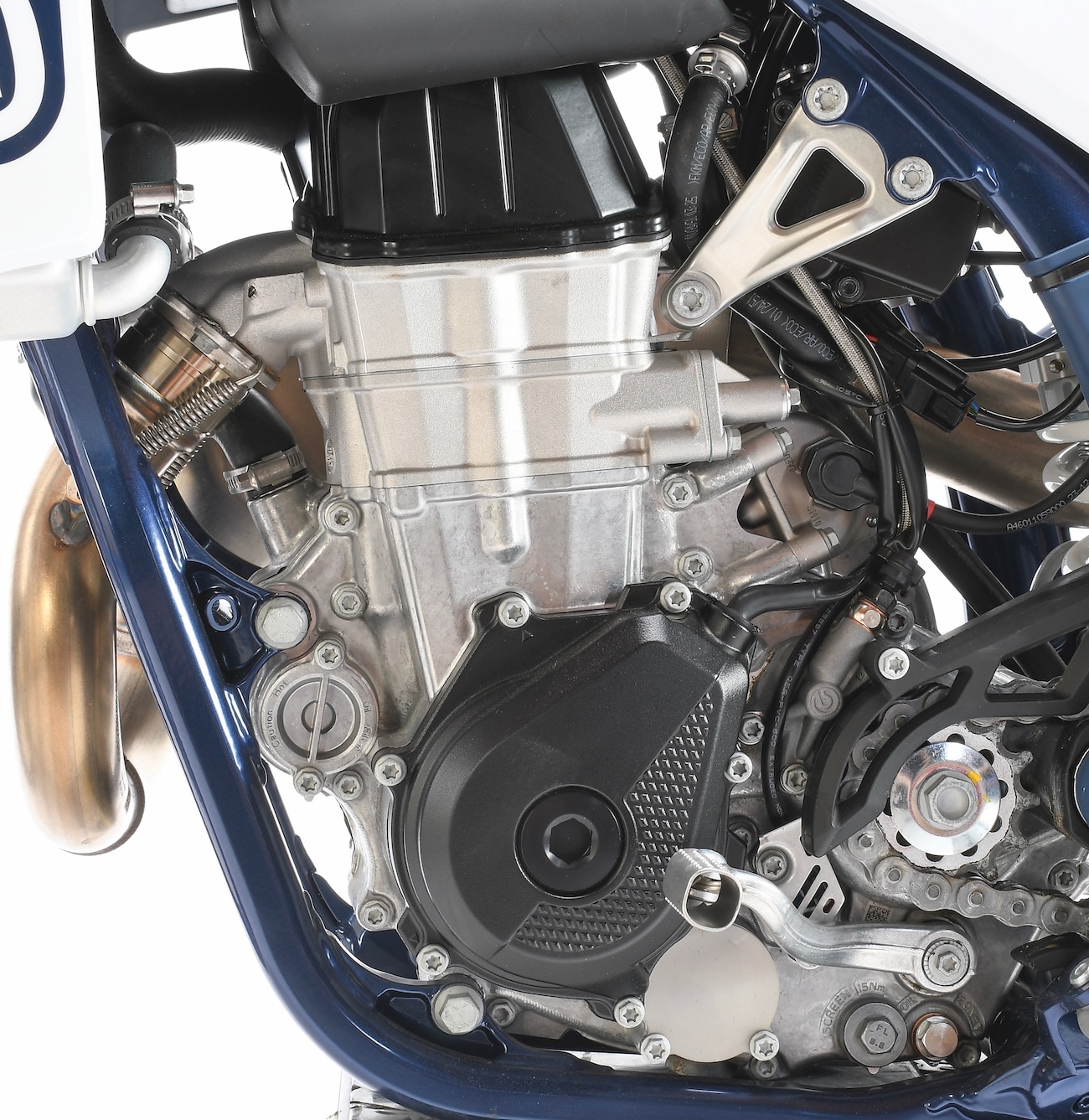 The 2025 Husqvarna FC450 has a broad powerband that builds a crescendo of power as the rpm climbs. It peaks at 60.1 horsepower—the most in the 2025 450 class.
The 2025 Husqvarna FC450 has a broad powerband that builds a crescendo of power as the rpm climbs. It peaks at 60.1 horsepower—the most in the 2025 450 class.
Q: WHAT’S NEW ON THE 2025 HUSQVARNA FC450 FORKS?
A: Husqvarna was the first manufacturer to come to the realization that with each passing year its bikes were getting taller and taller, but the riders weren’t. Riders who could previously touch the ground with their feet were now swinging their toes in thin air. The increased height wreaked havoc on rider equilibrium. It took more energy to get the taller bikes to turn—thanks to higher centers of gravity that made them tippy. So, Husqvarna decided to shorten its suspension travel and bring the chassis down approximately 1 inch. Here is how they did it.
The WP XACT air forks work well—if you are smart enough to learn how to set them up.
Starting with the 2021 models, the WP XACT forks were made 10mm shorter than the 2020 forks. To achieve this, Husqvarna shortened the cartridge rods by 10mm and made a corresponding 10mm reduction in the length of the WP stanchion tubes.
Why go to all that trouble when a 10mm spacer inserted into the forks could have achieved the same 10mm-shorter forks? Good question, but the answer is equally good. Husqvarna shortened both the cartridge rods and stanchion tubes to maintain the same separation between the bushings in the stanchions and fork internals. This increased fork rigidity while eliminating a spike in damping pressure.
WP’s engineers used the fork’s compression stroke air pressure on the rebound stroke to stop topping out. This was achieved by putting a cross-over bleed slot near the end of the compression stroke to allow the pumped-up air pressure to leak into the rebound side of the fork, resisting downward acceleration of the fork tubes. It was an ingeniously simple idea.
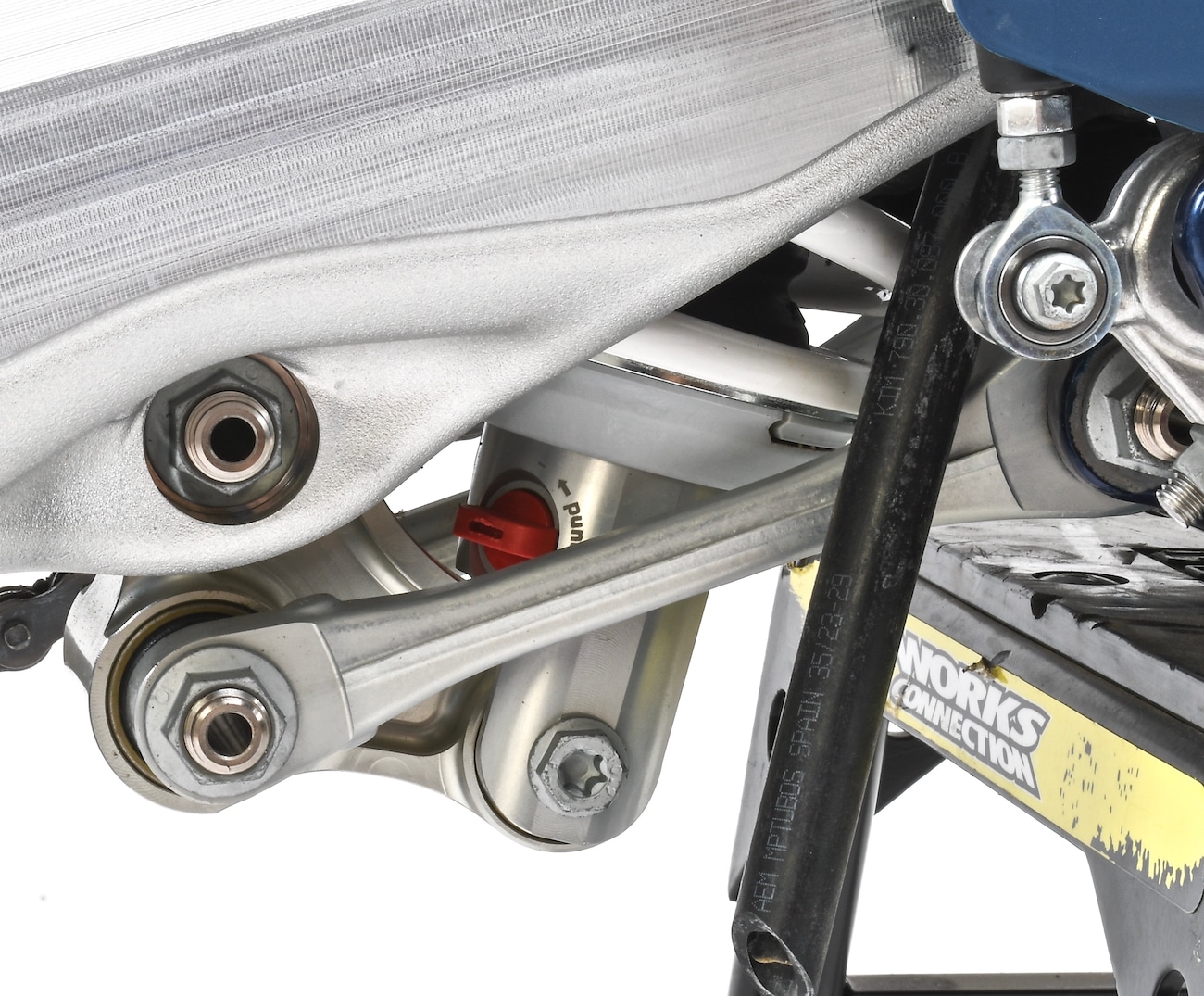 The smaller linkage bolts and slimmer linkage arms not only reduce friction but work in conjunction with the previously updated smaller rear axle. The linkarm are longer to help lower the FC450 by one inch.
The smaller linkage bolts and slimmer linkage arms not only reduce friction but work in conjunction with the previously updated smaller rear axle. The linkarm are longer to help lower the FC450 by one inch.
Q: WHAT’S NEW ON THE REAR SUSPENSION?
A: The biggest rear suspension changes revolve around the shock linkage—and the Husqvarna linkage features different mechanical measurements from the KTM or GasGas linkage. The Husky shock linkage is all new with the exception of the rising-rate curve. The rising-rate curve remains the same, as does the 45 N/mm shock spring. The biggest mods are to the actual linkage pieces. The linkage arms were 16.2mm tall on the 2024 model; for 2025, they are 13.6mm tall and 2mm thinner. The shock bolt that attached to the linkage’s bell crank is downsized from 17mm to 15mm, while the bolt on the other end of the bell crank is reduced from 17mm to 14mm. Even the ribbing on the flat sides of the bell crank, which was 6.3mm, is now 5.3mm wide.
Why all the downsizing of the link arms, bell crank and bolts? Husqvarna discovered in testing that the 2023-2024 linkage parts were too rigid. The smaller linkage bolts and slimmer linkage arms not only reduce friction but work in conjunction with the previously updated smaller rear axle to provide more feedback from the rear wheel and get the flex back where they wanted it.
Q: WHAT’S THE STORY ON THE ALL-NEW CONNECTIVITY UNIT?
A: Although Yamaha has taken the lead over the past few years when it comes to engine tuning via Wi-Fi, Husqvarna’s new Connectivity Unit can supply beaucoup engine-management options and full-blown analysis through the “Rider” section of the “Ride Husqvarna Motorcycles App.” Riders can access different levels of throttle response, traction control, launch control and engine braking and also engage preset maps for sand, gravel, hard-pack and wet dirt. Additionally, the 2025 Husqvarna FC450 can harness the power of LitPro to collect data about speed, acceleration, deceleration, average speed, G-forces, air-time, jump height, gearing, rpm, throttle position, water temperature and traction control. Best of all, LitPro can use its front-fender-mounted GPS unit to map the track you are riding on and play back the lines you use on every lap.
It should be noted that the KTM Connectivity Unit Offroad doesn’t come as standard equipment on the stock 2025 Husqvarna FC450. The optional retrofit CUO unit retails for $249.99, and to access the high-end LitPro features, you need a $69.99 annual subscription from Apple’s App Store or Google Play.
Q: HOW DOES THE 2025 HUSQVARNA FC450 RUN ON THE TRACK?
A: The engine, from top to bottom, delivers one long, churning, locomotive style of power. It builds at an unbelievably progressive rate from 5000 rpm to its peak at 9400 rpm. It’s strong on the bottom, stronger in the middle and strongest on top. It makes an impressive 60.1 horsepower at peak.
Unlike a lot of fast bikes, the 2025 Husqvarna FC450 remains supremely manageable whether you are tapped out in fifth or working your way through the esses in third. Torquey, broad, powerful and fun are the watchwords of the 2025 Husqvarna FC450.
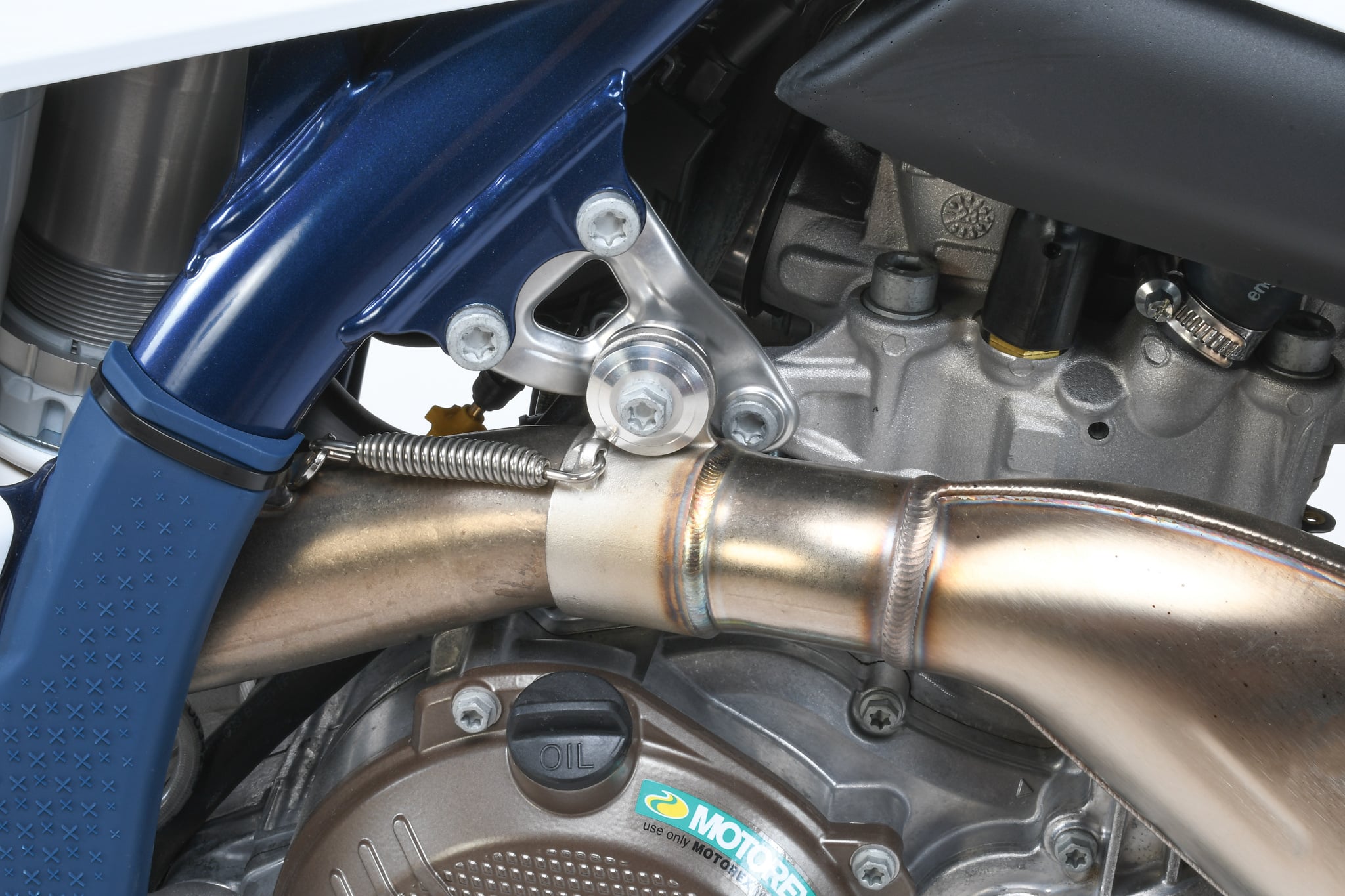 In addition to the frame changes, the head stays also got a relief hole to make them more flexible. This juncture of the head stay, mid pipe joint and pipe spring shows attention to detail.
In addition to the frame changes, the head stays also got a relief hole to make them more flexible. This juncture of the head stay, mid pipe joint and pipe spring shows attention to detail.
Q: HOW DOES THE 2025 HUSQVARNA FC450 HANDLE?
A: Every MXA test rider, all of whom have lots of hours on MXA’s stock 2024 Husqvarna FC450, raved about how the 2025 Husqvarna FC450 feels in motion. It is definitely an improvement over the stiff 2024 frame. Plus, it did not take 10 hours of break-in time to get the frame to feel comfortable.
The 2022 FC450 had squat issues, most evident in consecutive whoops, but by rotating the engine backwards the engineers were able to lower the countershaft sprocket by 3mm, which lessened squat under acceleration by reducing chain torque. This led to the improvement in rear-wheel traction.
As far as the 2025 crop of motocross bikes goes, they are generally examples of the “give to get” philosophy of frame design. The 2024 Yamaha, Kawasaki, Honda and Suzuki have all sacrificed stability at speed for the ability to turn tight. The result is that these bikes have a tendency to suffer head shake at speed and a touch of over-steer in the corners. These manufacturers focused on cornering prowess at the expense of straight-line stability.
The 2025 Husqvarna FC450 made no such compromises and is the best all-around handling bike on the track (aided in no small part by the lowered suspension). It is accurate in the corners, laser-guided down the straights, and doesn’t suffer from any chronic tendencies to over-steer in the tight stuff or shake over rough ground.
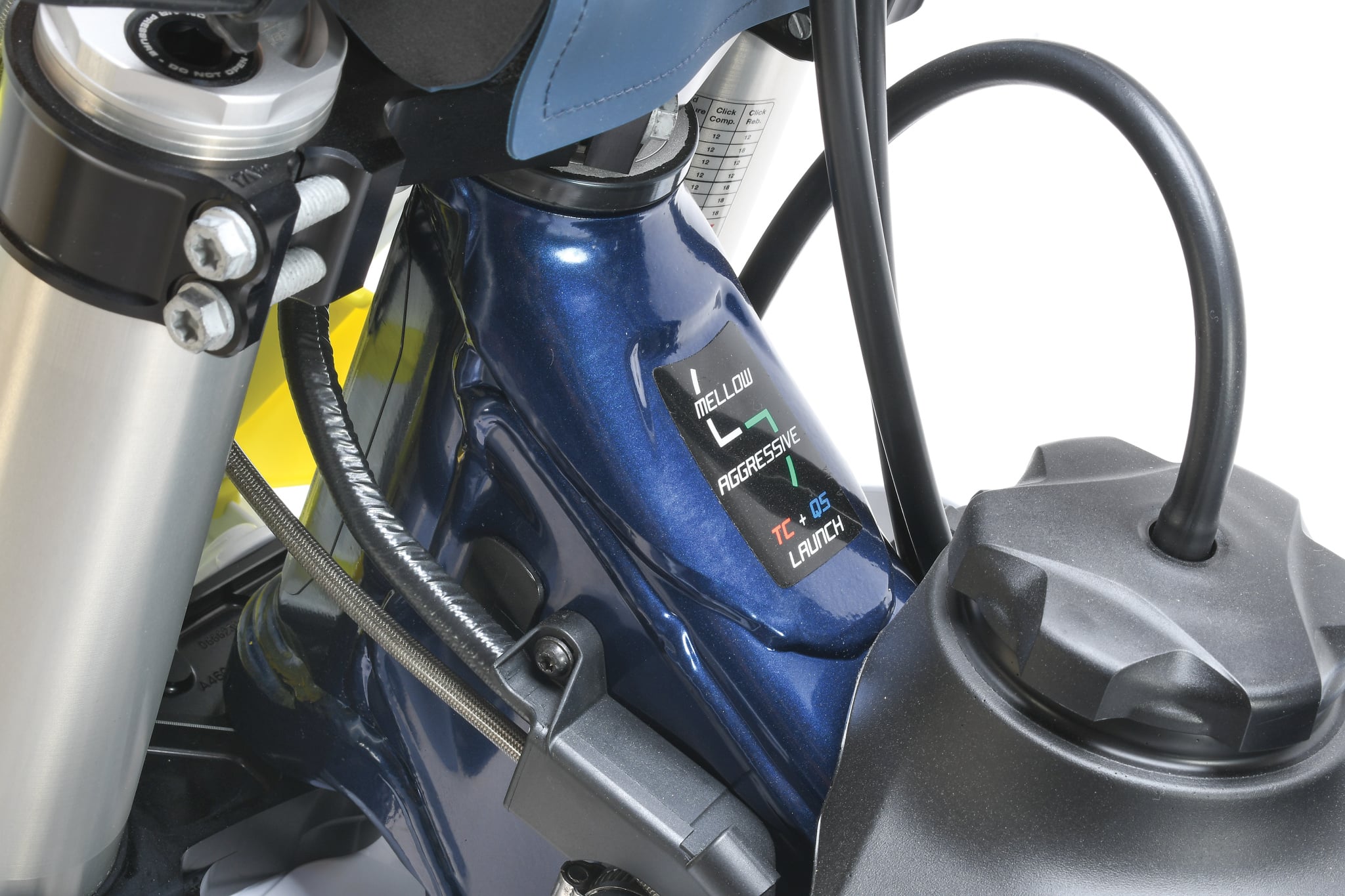 The forged plate on the top of the frame’s backbone was made out of thinner material for 2025. It doubles as a place to stick ECU map instructions.
The forged plate on the top of the frame’s backbone was made out of thinner material for 2025. It doubles as a place to stick ECU map instructions.
Q: WHAT DID WE HATE?
A: The hate list:
(1) Start/stop buttons. If you don’t like having the kill button on the right side of the handlebars, Nihilo Concepts makes separate start and stop buttons that retro-fit so you can put the kill button back on the left side.
(2) Chain slack. Be forewarned, you need 70mm of chain slack. That translates into four fingers under the chain at the back of the buffer pad. Yes, we know that you have always used three fingers to check your chain tension, but on the 2023-2025 KTM, Husky and GasGas models, you need to use four fingers. The chain is not right if it doesn’t look too loose.
(3) Finding neutral. Getting the transmission into neutral on the starting line is very hard. It resists being snicked into gear. Our solution is to rev the engine with the clutch pulled in, and when the rpm peaks, we shift into neutral as the rpm drop.
(4) Radiator cap. The plastic radiator cap is a pain to remove. Nihilo Concepts makes a removal tool to make it easier.
(5) Spokes. KTM’s spokes come loose all the time. If you can’t check all the spokes, be sure to check the spokes closest to the rear rim lock; if those spokes are loose, you need to tighten all the spokes.
(6) Shock clicker access. It’s nice that you don’t need tools to adjust the high- and low-speed compression clickers, but you do need to be able to get to them. Kiska, who designs the Husqvarna bodywork, has made a habit of flubbing the design of the right-side shroud. We recommend using a hole saw drill bit to cut a circular opening in the side panel to give you access to the high- and low-speed clickers.
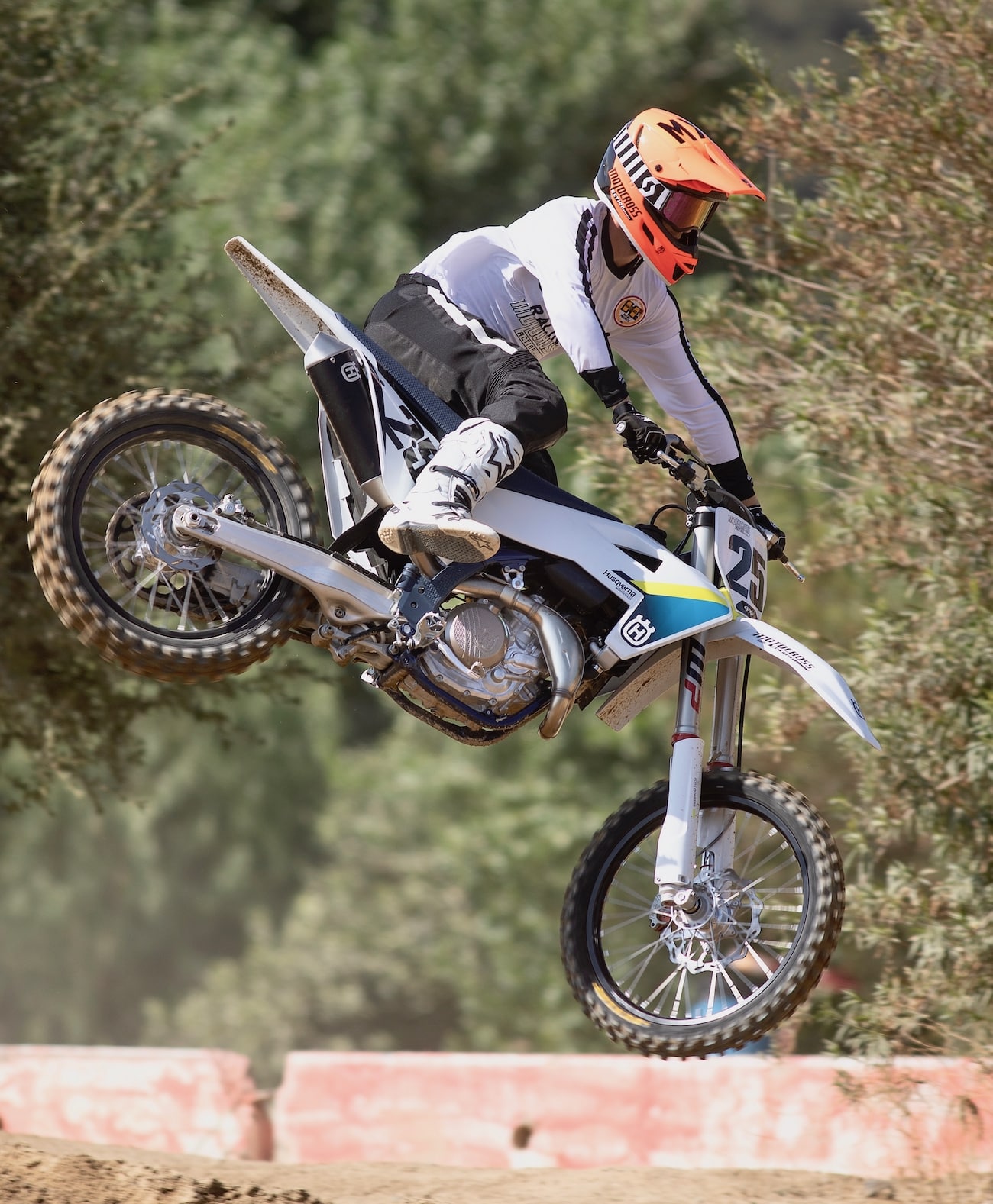 Although the suspension travel has been shortened, the actual rider triangle has the same dimension on the Husky as on the KTM and GasGas.
Although the suspension travel has been shortened, the actual rider triangle has the same dimension on the Husky as on the KTM and GasGas.
Q: WHAT DID WE LIKE?
A: The like list:
(1) Brakes. The front brake on a Husky is not only powerful but has an incredible range of modulation. It allows for one finger stopping.
(2) Shock collar. WP’s latest shock collar is much easier to use and more durable than it was in the past.
(3) Vented airbox cover. You get two airbox covers when you buy a Husqvarna: a stock cover and an optional vented cover. MXA test riders always prefer the vented cover, except on dusty or wet tracks.
(4) Quickshift. For 2025, there are two different QuickShift reaction speeds: one for upshifts through third gear and one for upshifts from fourth to fifth gear, but you. need the Connectivity Unit to access them.
(5) Radiator shrouds. The new radiator shrouds aren’t as pointy as the 2023–’24 shrouds. They curve inward at the tips to keep them out of the way. The overall effect is that the bodywork feels narrower at your knees.
(6) Brake pedal. The brake-pedal tip on previous models could easily be crushed in a collision with another bike or by the ground. For 2025, the brake pedal is stronger and the brake-pedal tip has been reinforced.
(7) Maps. Even if you don’t go with the optional CUO, the two embedded maps on the left-side switchgear provide two pretty distinct options. Most MXA test riders prefer the white map.
Q: WHAT DO WE REALLY THINK?
A: MXA has always expressed a desire for the three Austrian brands to differentiate themselves from each other. Of course, the Pierer Mobility Group prefers to keep them close to the same, because that is what makes “platform sharing” a money saving concept. The 2025 Husqvarna FC450 is different enough from its KTM and GasGas brothers to deserves praise, not just for how well it performs, but because it is the only 450cc motocross bike that is low enough to suit short riders without frustrating tall riders.


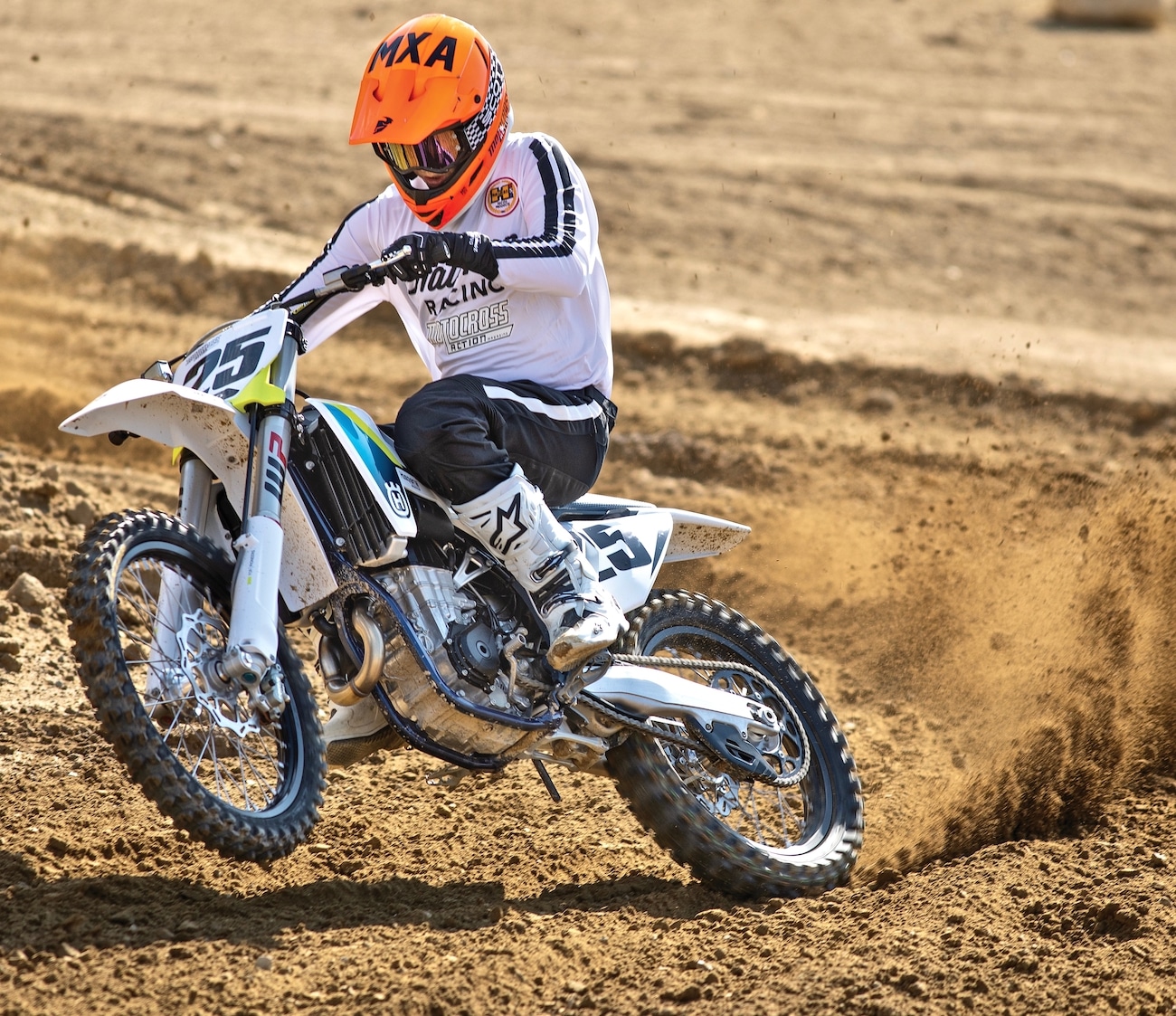
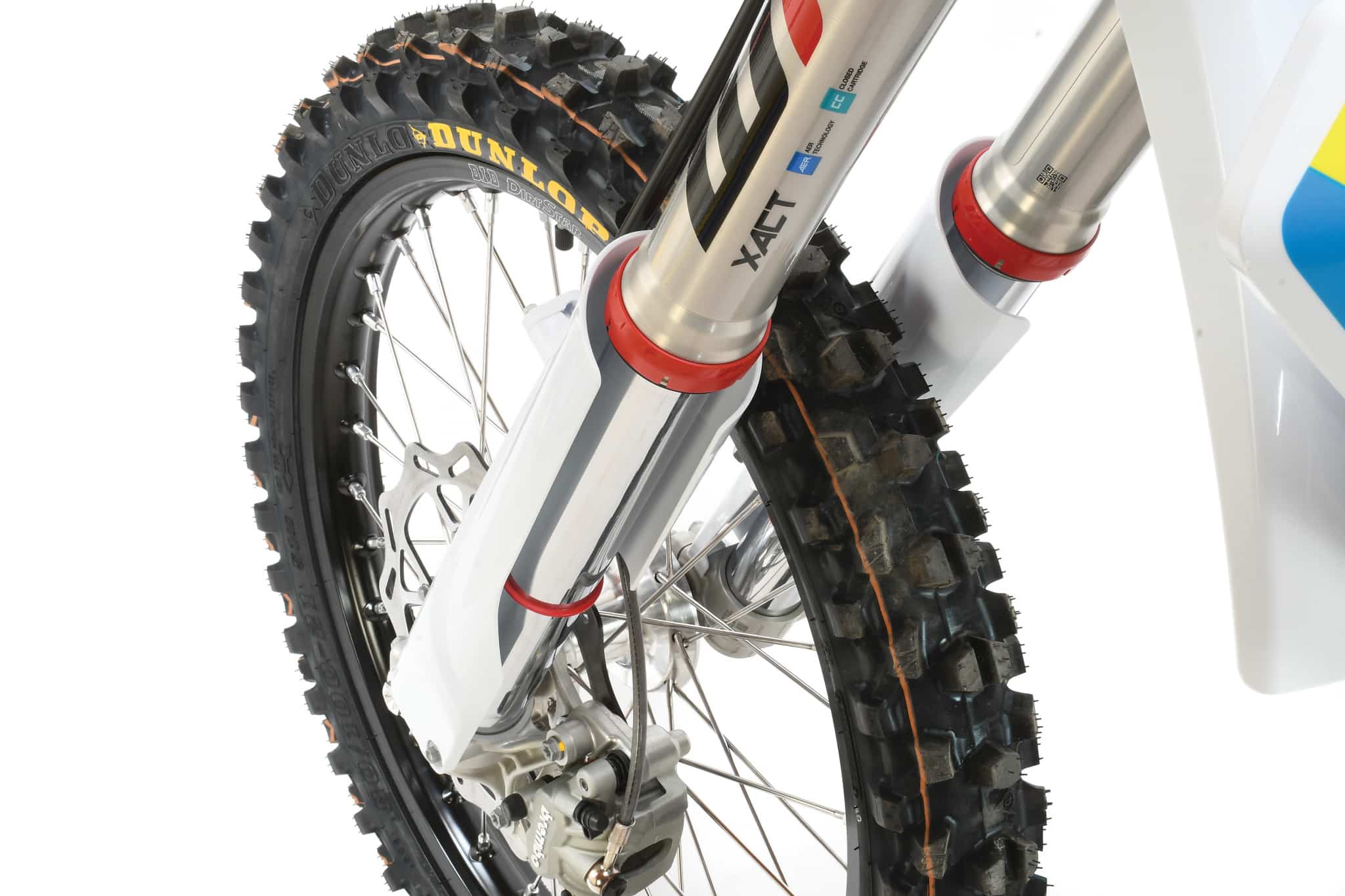

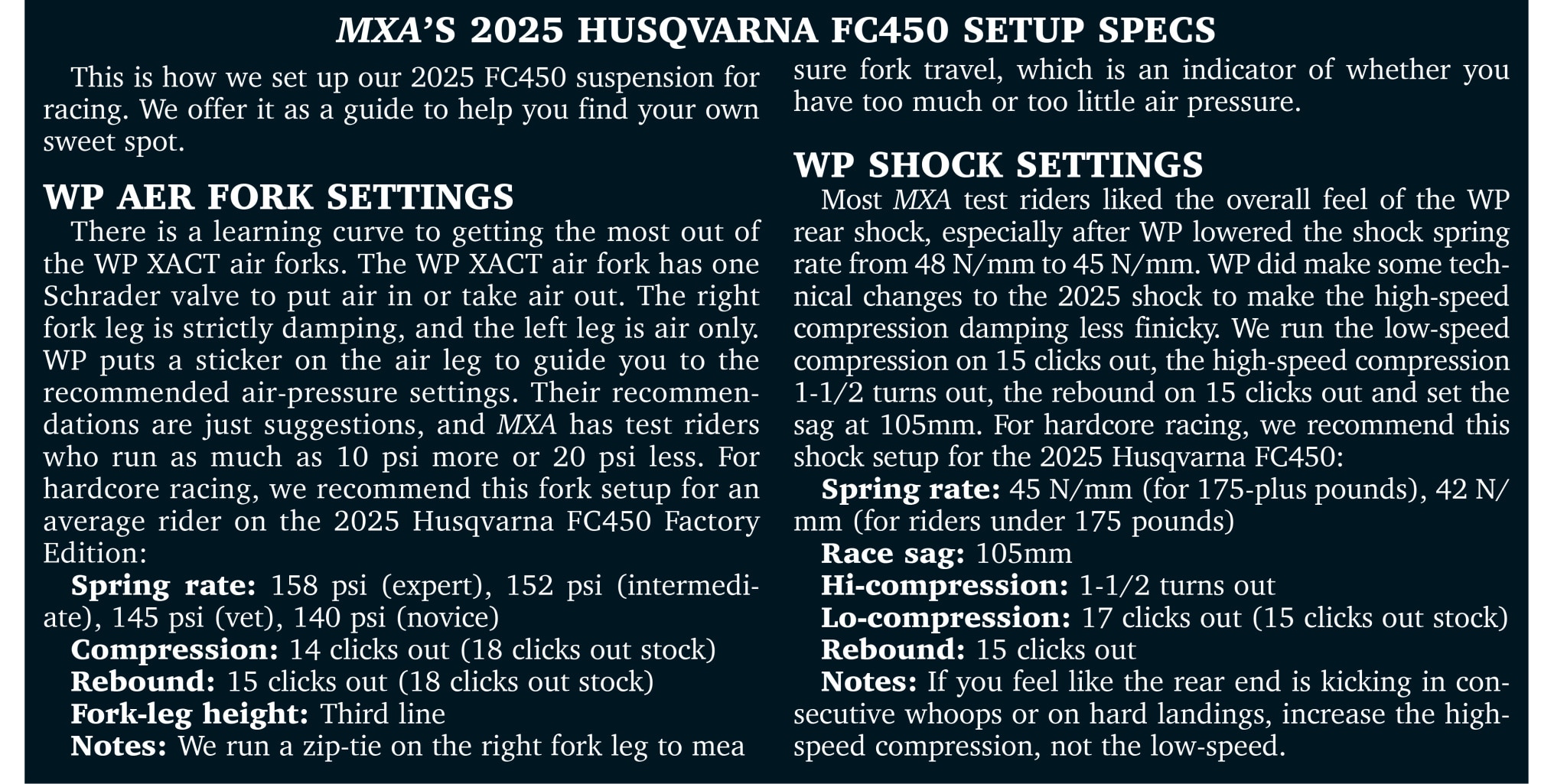




Comments are closed.